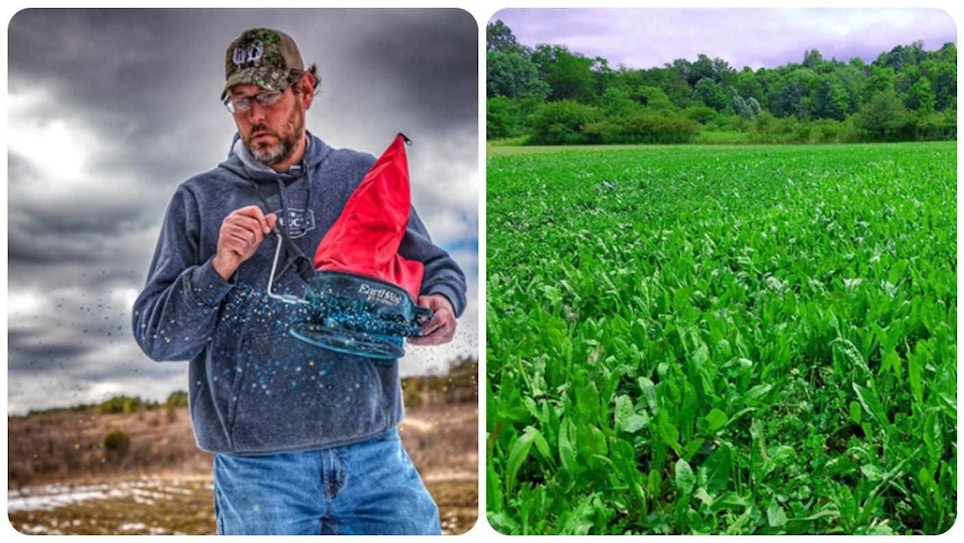Jason Say (above left) enjoys teaching other whitetail hunters how to manage their land more effectively to maximize its potential to grow healthy deer, including bigger bucks. Based in Pennsylvania, he consults with landowners throughout the eastern United States, including clients in Connecticut, Kentucky, Maryland, New York, Ohio, Pennsylvania and West Virginia.
His company is called Field Days, and besides offering habitat management services, Jason has also been a fixture in producing whitetail hunting content, including podcasts and YouTube videos. “On the hunting side, I've been playing with food plots since I started hunting years ago, and things just progressed to where I’m consistently shooting big bucks in a state that's not known for big bucks,” he said. “There's nothing I love more than working hard on a piece of property and making it what my customer wanted it to be – a big buck property.”
The Nitty Gritty of Frost Seeding
During late-winter, the topic of frost seeding comes up more in conversation with hunters managing food plots. While often misunderstood, states Jason, it’s a great way to get your plot going early without the need for a lot of machinery. “I love frost seeding because it's an unbelievably simple method to establish a great food plot.”
Jason offers these five proven tips for frost seeding success.
1. Timing Is Everything
“The key is timing,” Jason said. “No matter what region you’re in, when you get to the last week where you’re toggling between freezing and thawing — basically, when it freezes at night and thaws in the afternoon during daylight, that’s when you want to do your frost seeding. In northwest Pennsylvania, that typically means the middle of March, but it will vary from state to state.”
2. Think Perennials
“Frost seeding is how I establish perennial plots of clover and chicory, specifically a blend called Fusion from The Whitetail Institute, that the deer absolutely love here,” Jason said. Perennial seeds are tiny, giving them the best chance to work into the soil during late-winter and early spring freezing and thawing cycles, which causes the ground to expand and contract.
“You might have a clover plot from the year before with some bare spots, due to lack of seed or drought,” he said. “In this case, frost seeding is a great way to thicken up the clover. It’s simple. All you need is a hand spreader; there’s no discs or tillers involved. It’s all about making seed-to-soil contact.”
3. Read the Label
How much seed should you broadcast? According to Jason, a general rule of thumb is if you’re working with an existing perennial plot where there was clover the year before, spread at the rate that’s recommended for new planting your particular blend. Most seed companies recommend about 8 pounds an acre, or 4 pounds per half acre.
4. Manage Weeds
Once the ground starts to warm, you’ll see the clover starting to sprout, and once it gets to 4 or 5 inches tall, you’ll want to spray it with herbicides. Jason recommends Arrest Max and Slay from The Whitetail Institute, which control grasses and broadleaf weeds. Then, in summer, he recommends mowing the clover to 4 or 5 inches to help control weeds.
5. Rotate Your Plantings
“Let's say you had an annual plot the year before, like turnips or radishes, which you plant every year,” Jason said. “The method that has worked well for me is planting annuals for 2 years and then rotating them. Every time I need to rotate an annual plot into a perennial, I will simply go out and frost seed in the middle of March, which works 60-70% of the time. This saves me having to get the disk out and spray everything. Frost seeding is simple at the start, with a little bit of spring and summer maintenance, and then you end up with a great-looking perennial plot come fall.”
At the end of the day, frost seeding is a great way to establish food plots without banging up your soil with discs and tillers with positive results and minimized, yet strategic effort.
Check out the 6-minute YouTube video below from Jason Say on the topic of frost seeding. What the weather forecast and don’t miss your opportunity this late-winter or early spring!






